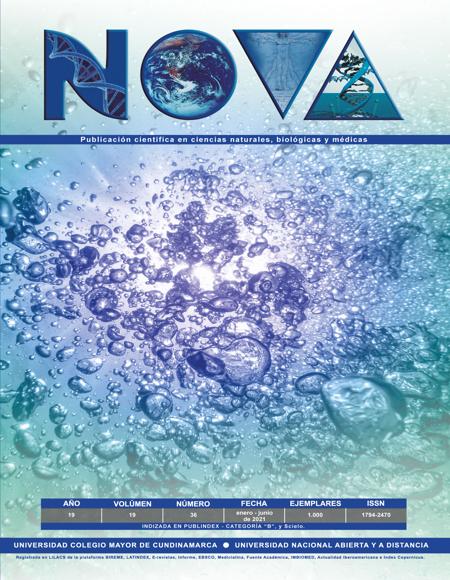Microorganismos xerófilos cultivables de la zona semiárida de la Tatacoa (Colombia).
Culture xerophile microorganisms from the Tatacoa semiarid zone (Colombia).

NOVA por http://www.unicolmayor.edu.co/publicaciones/index.php/nova se distribuye bajo una Licencia Creative Commons Atribución-NoComercial-SinDerivar 4.0 Internacional.
Así mismo, los autores mantienen sus derechos de propiedad intelectual sobre los artículos.
Mostrar biografía de los autores
Introducción. Los microorganismos xerófilos han adquirido una mayor relevancia para la realización de investigaciones relacionadas con sus mecanismos adaptativos frente al estrés hídrico, así como la caracterización e identificación de sus hábitats. En Colombia, las zonas semiáridas y desérticas como el desierto de la Tatacoa han sido poco estudiadas a nivel microbiano. Objetivo. Aislar y caracterizar microorganismos xerófilos provenientes del suelo de la zona semiárida de la Tatacoa del departamento del Huila (Colombia). Materiales y métodos. Se colectaron muestras en los sectores denominados localmente como Cuzco y La Victoria, las cuales fueron procesadas para el aislamiento de microorganismos xerófilos en medio selectivo M40Y para posterior caracterización macro y microscópica, así como evaluación mediante pruebas bioquímicas para la utilización de sustratos. Resultados. Fueron aislados 29 morfotipos entre los cuales se pudieron diferenciar: Bacilos y cocos Gram positivos presentes exclusivamente en el sector del Cuzco y bacterias filamentosas ramificadas (actinobacterias) únicamente en el sector de La Victoria. Se estableció la presencia de los géneros Streptomyces, Micrococcus y Corynebacterium. Conclusiones. La presencia de microorganismos relacionados con los géneros anteriormente mencionados permitirá comprender las posibles interacciones que se presentan en este ecosistema, lo que aportará al desarrollo de este lugar como un posible análogo para estudios de búsqueda de vida en otros planetas como Marte. Además, incentivar estudios más detallados donde se puedan recuperar microorganismos que sean de utilidad para diferentes procesos biotecnológicos.
Visitas del artículo 1502 | Visitas PDF 447
Descargas
- Gargaud M. Encyclopedia of astrobiology, Berlin: Springer Science & Business Media; 2011. https://www.springer.com/gp/book/9783642112744
- Scott W. Water Relations of Food Spoilage Microorganisms. Advances in Food Research. 1957;(7): 83-127. https://doi.org/10.1016/S0065-2628(08)60247-5
- Pitt J, Hocking A. Fungi and food Spoilage. Verlag: Springer. 2009. https://www.springer.com/gp/book/9780387922065
- Petrovič U, Gunde-Cimerman N, Zalar P. Xerotolerant mycobiota from high altitude anapurna soil, nepal. FEMS microbiology letters. 2000; 128(2): 339- 342. https://doi.org/10.1111/j.1574-6968.2000.tb08918.x
- Sharma A,Sharma R, Devi T. Life at extreme conditions: Extremophiles and their biocatalytic potential. En: 3rd International conference on recent advances in engineering science and management. Pune: 2017. https://www.semanticscholar.org/paper/Life-at-extreme-conditions%3A-Extremophiles-and-their-Sharma-Sharma/4ebc1e2814fe20fe66396856bdd8d130704b5762
- Srivastava A, Rai A, Kumar S, Kashyap P, Arora D. Extremophiles: Potential Sources of Biomolecules. En: Prakash S, Sharma R, Kunwar R. Recent advances in microbiology. Nueva York: NOVA; 2013. p.551-564. https://www.researchgate.net/publication/249314487_Extremophiles_Potential_Sources_of_Biomolecules
- Dion P. Soil Biology and Agriculture in the Tropics. Berlin: Springer; 2010. https://www.springer.com/gp/book/9783642050756
- Schulze-Makuch D, Houtkooper J. A perchlorate strategy for extreme xerophilic life on Mars. En: EPSC Abstracts. Rome; 2010. https://meetings.copernicus.org/epsc2010/abstracts/EPSC2010-308.pdf
- Stevenson A, Burkhardt J, Cockell C, Cray J, Dijksterhuis J, Fox-Powell M, et al. Multiplication of microbes below 0.690 eater activity: Implications for terrestrial and extraterrestrial life. Environmental microbiology. 2015; 17(2): 257-277. https://doi.org/10.1111/1462-2920.12598
- Lebre P, De Maayer P,Cowan D. Xerotolerant bacteria: surviving through a dry spell. Nature Reviews Microbiology. 2017; 15(5): 285-296. https://doi.org/10.1038/nrmicro.2017.16
- Okoro C, Brown R, Jones A, Andrews B, Asenjo J, Goodfellow M, et al. Diversity of culturable actinomycetes in hyper-arid soils of the Atacama Desert, Chile,Antonie Van Leeuwenhoek. 2009; 95(2): 121-133. https://pubmed.ncbi.nlm.nih.gov/19052913/
- Santhanam R, Okoro C, Rong C, Huang Y, Bull A, Weon H, et al. Streptomyces atacamensis sp. nov., isolated from and extreme hyper-arid soil of the Atacama Desert, Chile. International journal of systematic and evolutionary microbiology. 2012; 62(11): 2680-2684. https://doi.org/10.1099/ijs.0.038463-0
- Santhanam R, Rong X, Huang Y, Andrews B, Asenjo J, Goodfellow M. Streptomyces bullii sp. nov., isolated from a hyper-arid Atacama Desert soil. Antonie Van Leeuwenhoek. 2013; 103(2): 367- 373. https://doi.org/10.1007/s10482-012-9816-x
- Azua-Bustos A, Urrejola C, Vicuña R. Life at the dry edge: microorganisms of the Atacama Desert. FEBS Letters. 2012; 586(18): 2939-2945. https://doi.org/10.1016/j.febslet.2012.07.025
- Piubeli F, De Lourdes M, Kishi L, Henrique-Silva F, García M, Mellado E. Phylogenetic profiling and diversity of bacterial communities in the death valley, an extreme habitat in the atacama desert. Indian journal of microbiology. 2015; 55(4): 392- 399. https://doi.org/10.1007/s12088-015-0539-3
- Drees K, Neilson J, Betancourt J, Quade J, Henderson D, Pryor B, et al. Bacterial community structure in the hyperarid core of the Atacama Desert, Chile,Applied and Environmental Microbiology. 2006; 72(12): 7902-7908. https://aem.asm.org/content/72/12/7902
- Direito S, Ehrenfreund P, Marees A, Staats M, Foing B, Roling W. A wide variety of putative extremophiles and large beta-diversity at the mars desert research station (utah). International Journal of Astrobiology. 2011; 10(3): 191-207. https://doi.org/10.1017/S1473550411000012
- Montero-Calasanz M, Goker M, Potter G, Rohde M, Sproer C, Schumann P, et al. Geodermatophilus arenarius sp. nov., a xerophilic actinomycete isolated from Saharan desert sand in Chad. Extremophiles. 2012; 16(6): 903-909. https://doi.org/10.1007/s00792-012-0486-4
- Mohammadipanah F, Wink J. Actinobacteria from arid and desert habitats: diversity and biological activity. Frontiers in microbiology. 2016; 6: 1541. https://doi.org/10.3389/fmicb.2015.01541
- Kurapova A, Zenova G, Sudnitsyn I. Thermotolerant and thermophilic actinomycetes from soils of Mongolia desert steppe zone,Microbiology. 2012;81: 98-108. https://doi.org/10.1134/S0026261712010092
- Taketani R, Kavamura V, Dos Santos S. Diversity and Technological Aspects of Microorganisms from Semiarid Environments. Diversity and Benefits of Microorganisms from the Tropics. 2017: 3-19. https://link.springer.com/chapter/10.1007/978-3-319-55804-2_1
- Cowan DA, Hopkins DW, Jones BE, Maggs-Kölling G, Majewska R, Ramond J-B. Microbiomics of Namib Desert habitats. Extremophiles [Internet]. 2020;24(1):17–29. https://doi.org/10.1007/s00792-019-01122-7
- Belov A, Cheptsov V, Vorobyova EA, Manucharova NA. Culturable Bacterial Communities Isolated from Cryo-Arid Soils : Phylogenetic Culturable Bacterial Communities Isolated from Cryo-Arid Soils : Phylogenetic and Physiological Characteristics. 2020;54(8): 95-104. http://dx.doi.org/10.1134/S0031030120080043
- Lombana A. Suelos Colombianos: Una mirada desde la academia. Bogotá: Universidad Jorge Tadeo Lozano; 2004. https://www.utadeo.edu.co/es/publicacion/libro/editorial/235/suelos-colombianos-una-mirada-desde-la-academia
- Florez M, Parra L, Jaramillo D, Jaramillo J. Paleosuelos del mioceno en el desierto de la tatacoa. Revista de la Academia Colombiana de Ciencias Exactas, Físicas y Naturales. 2013; 37(143): 229-244. https://doi.org/10.18257/raccefyn.6
- Méndez YN. Identificación de bacterias nativas del desierto de Candelaria y Tatacoa (Colombia), sometidas a simulación de la radiación UV de Marte. Bogotá: Departamento de Ciencias Biológicas Universidad de los Andes; 2013. http://biblioteca.uniandes.edu.co/acepto22013220.php?id=3425.pdf
- Guerrero J. Stratigraphy and sedimentary environments of the Honda Group in the La Venta area. Miocene uplift of the Colombian Andes. En: Kay R, Madden R, Cifelli R, Flynn J. A history of Neotropical Fauna: Vertebrate Paleobiology of the Miocene of Tropical South America,, Washington D.C: Smithsonian Institution Press; 1994. p. 592. https://www.researchgate.net/publication/313608799_Stratigraphy_Sedimentary_Environments_and_the_Miocene_Uplift_of_the_Colombian_Andes
- Hermelin M. The Tatacoa Desert. En: Hermelin M. Landscapes and landforms of Colombia. New York: Springer; 2016. p. 127-138. https://www.springer.com/de/book/9783319117997
- Goodfellow M, Peter K, Busse H, Trujillo M, Ludwig W, Suzuki K. Part A. Bergey’s Manual of Systematic Bacteriology: Volume 5: The Actinobacteria. New York: Springer; 2012. https://www.springer.com/gp/book/9780387950433
- Winn W, Koneman E, Koneman W, Procop E, Schreckenberger G, Woods P, et al. Koneman diagnostico microbiológico: texto y atlas en color. Bogotá D.C.: Editorial Médica Panamericana; 2008. https://books.google.com.co/books/about/Koneman_Diagnostico_Microbiologico_Micro.html?hl=es&id=jyVQueKro88C&redir_esc=y
- Carroll K, Jorgensen J, Pfaller M. Manual of Clinical Microbiology, Washington D.C.: ASM Press; 2015. https://www.asmscience.org/content/book/10.1128/9781555817381
- Bull A, Asenjo J. Microbiology of hyper-arid environments: recent insights from the Atacama Desert, Chile. Antonie Van Leeuwenhoek. 2013; 103(6): 1173-1179. https://doi.org/10.1007/s10482-013-9911-7
- Santos SN, Gacesa R, Taketani RG, Long PF, Melo IS. Genome Sequence of Streptomyces caatingaensis CMAA 1322, a New Abiotic Stress-Tolerant Actinomycete Isolated from Dried Lake Bed Sediment in the Brazilian Caatinga Biome. Genome announcements. 2015; 3(5): 1015-1020. https://mra.asm.org/content/3/5/e01020-15.short
- Stevenson A, Hallsworth J. Water and temperature relations of soil actinobacteria. Environmental microbiology reports. 2014; 6(6): 744-755. https://doi.org/10.1128/genomea.01020-15
- Zvyagintsev D, Zenova G, Doroshenko E, Gryadunova A, Gracheva T, Sudnitsyn I. Actinomycete growth in conditions of low moisture. Biology Bulletin. 2007; 34(3): 242-247. https://doi.org/10.1134/S1062359007030053
- Anandan R, Dharumadurai D, Manogaran GP. An introduction to actinobacteria. En: Dharumadurai D, Jiang Y. Actinobacteria-Basics and Biotechnological Applications. InTech; 2016. https://www.intechopen.com/books/actinobacteria-basics-and-biotechnological-applications/an-introduction-to-actinobacteria
- Adhya TK, Kumar N, Reddy G, Podile AR, Bee H, Samantaray B. Microbial mobilization of soil phosphorus and sustainable P management in agricultural soils. Curr Sci. 2015;108:1280–1287. https://www.jstor.org/stable/24905489
- Ávila I, Rodríguez M, Franco M, Pedroza A, Gutierrez I. Use of agricultural wastes for biomass production of the plant growth promoter actinobacteria, streptomyces sp. mcr26. Journal of Experimental Biology and Agricultural Sciences. 2014;2(5): 460- 472. https://www.intechopen.com/books/actinobacteria-basics-and-biotechnological-applications/an-introduction-to-actinobacteria
- Sivaraman G, Siva V. Microbiological spoilage of dried dishes. SSRN. 2015;2709070: 1-5. https://dx.doi.org/10.2139/ssrn.2709070
- Dilbaghi N, Sharma S. Food spoilage, food infections and intoxications caused by microorganisms and methods for their detection. 2007. https://www.semanticscholar.org/paper/Food-spoilage%2C-food-infections-and-intoxications-by-Dilbaghi-Sharma/bf1979600620a-165f83e3e27433c6121531aeb9f
- Hocking A, Isolation and identication of xerophilic fungi in stored commodities. En: Champ B, Highley E, Hocking A, Pitt J. Fungi and Mycotoxins in Stored Products, Canberra: Australian Centre for International Agricultural Research; 1991. p. 266. https://ageconsearch.umn.edu/record/134649/files/PR036.pdf#page=62
- Nicolaus B, Manca M, Lama L, Esposito E, Gambacorta A. Lipid modulation by environmental stresses in two models of extremophiles isolated from Antarctica. Polar Biology. 2001; 24(1): 1-8. https://doi.org/10.1007/s003000000156
- Satyanarayana T, Raghukumar C, Shivaji S. Extremophilic microbes: Diversity and perspectives. Current Science. 2005: 78-90. https://www.researchgate.net/publication/298223942_Extremophilic_microbes_Diversity_and_perspectives
- Fredsgaard C, Moore D, Al Soudi D, Crisler D, Chen F, Clark B, et al. Relationships between sucretolerance and salinotolerance in bacteria from hypersaline environments and their implications for the exploration of mars and the icy worlds. International Journal of Astrobiology.2016: 1-7. https://doi.org/10.1017/S1473550416000240
- Rillig M, Lehmann A, Aguilar-Trigueros CA, Antonovics J, Caruso T, Hempel S, et al. J. Soil microbes and community coalescence. Pedobiología. 2016; 59(1): 37-40. https://doi.org/10.1016/j.pedobi.2016.01.001
- Tse C, Ma K. Growth and metabolism of extremophilic microorganisms. En: P. Rampelotto. Biotechnology of Extremophiles. Springer; 2016. p. 1-46. https://link.springer.com/chapter/10.1007/978-3-319-13521-2_1
- Huang W, Ertekin E, Wang T, Cruz L, Dailey M, DiRuggiero J, et al. Mechanism of water extraction from gypsum rock by desert colonizing microorganisms. Proc Natl Acad Sci U S A. 2020;117(20):10681–10687. https://doi.org/10.1073/pnas.2001613117
- Narvaez-Reinaldo J, Barba I, Gonzalez-Lopez J, Tunnacliffe MM. Rapid method for isolation of desiccation-tolerant strains and xeroprotectants. Applied and environmental microbiology. 2010; 76(15): 5254-5262. https://aem.asm.org/content/76/15/5254
- Vilchez S, Manzanera M. Biotechnological uses of desiccation-tolerant microorganisms for the rhizoremediation of soils subjected to seasonal drought. Applied microbiology and biotechnology. 2011; 91(5): 1297-1304. https://doi.org/10.1007/s00253-011-3461-6
- Chen G, XR J. Next generation industrial biotechnology based on extremophilic bacteria. Current opinion in biotechnology. 2018; 50(94): 94-100. https://doi.org/10.1016/j.copbio.2017.11.016





